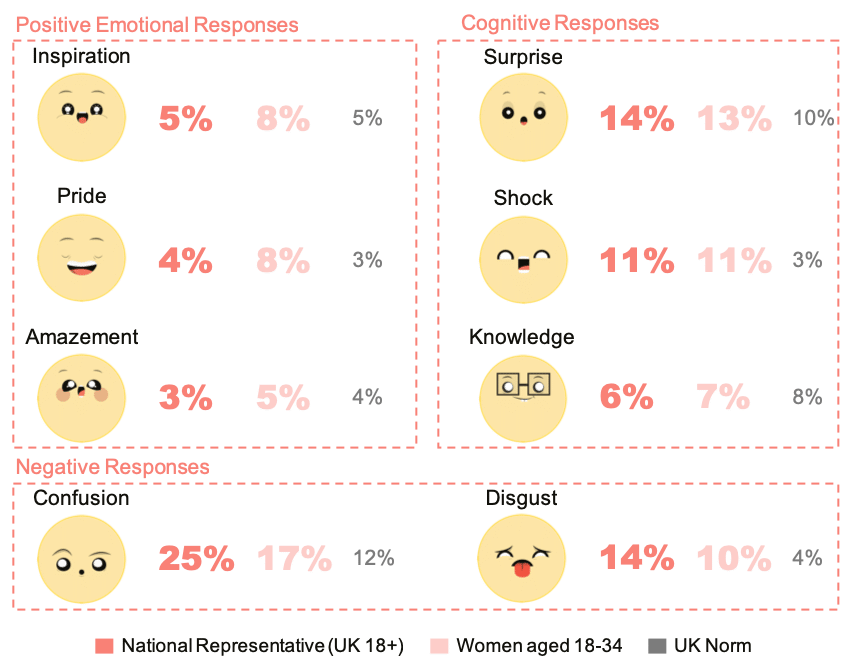E is for Emotions
As part of our A-Z of Adtech series, this week two of our Insights team, Holly Morrison and Johanna Hansson, looked back at one of Bodyform’s most innovative and thought provoking ads entitled Blood, in order to showcase the different layers of emotional response captured by biometric versus survey methods.
To do this we’re going to look at two different methods of capturing and analysing emotional responses, the different results these provide and the importance of combining these to give brands a complete view of an ad’s emotional performance.
https://www.youtube.com/watch?v=N-yIBD7cOUg
Generally we find that positive emotional responses increase brand effects and give an uplift in sales volume when compared to rational or unemotional ads. This is because an emotional video allows the viewer to connect with the brand, to create memories and build brand perception, such a connection has a tendency to filter through to follow-up intent. As a result it is vital for brands to understand the emotions their ads evoke.
Based on the survey data for Bodyform’s ‘Blood’ ad, we can see that a UK national representative sample had an intense positive emotional response in line with the UK norm, and women aged 18-34 showed a slight uplift. Inspiration, pride and amazement came through as the strongest positive emotions.

It is important to note that the emotional response for ‘Blood’ likely could have been stronger had it not been for a large proportion of viewers feeling confused by the content. Confusion tends to heavily impede emotional responses, as it has a tendency to influence the focus of the viewer which often changes to annoyance rather than engagement. The ad also saw a noticeably high level of disgust from viewers, emphasising the polarising effect of the ad.
Driving cognitive responses often results in an amplified emotional response. However, in this case surprise and shock are likely, due to the blood and the intensity of the imagery, and hence these responses are likely drivers of inspiration and pride but also disgust.
This survey result provides the brand with crucial information as it is evident the ad has evoked key emotions in line with the theme of empowerment, although it is worth noting that these could have been further amplified by avoiding high confusion and disgust.
Biometric facial coding is another way to trace emotional engagement, specifically subconscious responses. The emotions selected by viewers shown in the survey results show the overall emotional response. Facial coding further helps to understand exactly which scenes drove these responses. This is necessary to get a full picture of what emotions the ad evoked and the key scenes driving these.

The facial coding results for ‘Blood’ show that viewers predominantly smiled after the woman clicks her toes and the music intensifies. It can be deduced that the lack of smiles in the first half of the video could be due to viewers being a combination of surprised and confused by the content, as seen from the survey. The facial coding also shows that music played a key part in this video in influencing viewers’ emotions, as many peaks in smile where accompanied with the music intensifying or restarting.
The subconscious reactions captured by facial coding adds an important layer of analysis that helps in explaining the inspiration, pride and amazement evident in the survey results. In turn, this allows Bodyform to know which specific scenes to edit in order to drive their overall positive emotional response. If the brand was to make a shorter version of the video to drive incremental reach they could use the facial coding results to pick the strongest elements of the video that evoked the greatest reactions from viewers.
Facial coding results delve into what subconsciously moved the audience to the extent that they expressed those emotions in the survey. This demonstrates the crucial argument of taking both measurements into consideration; survey data lacks colour without facial coding, whilst facial coding alone does not offer the emotional granularity and robustness as quant data of a survey. Together these two measurements of emotional responses form a holistic picture of how the ad moved the audience.
Click here to find out more about our UnrulyEQ offering.
Click here to see other articles in the A-Z of Adtech series.
